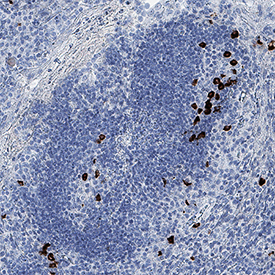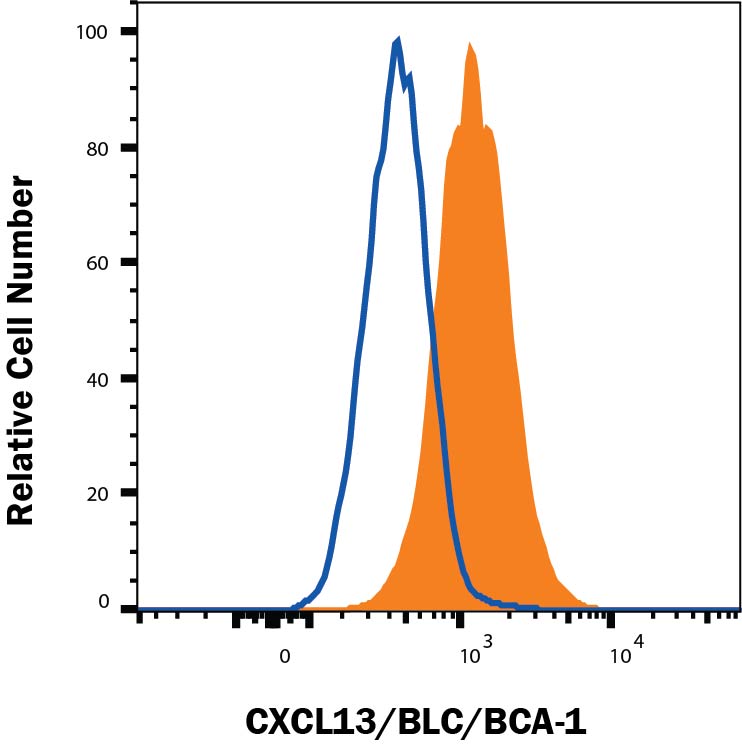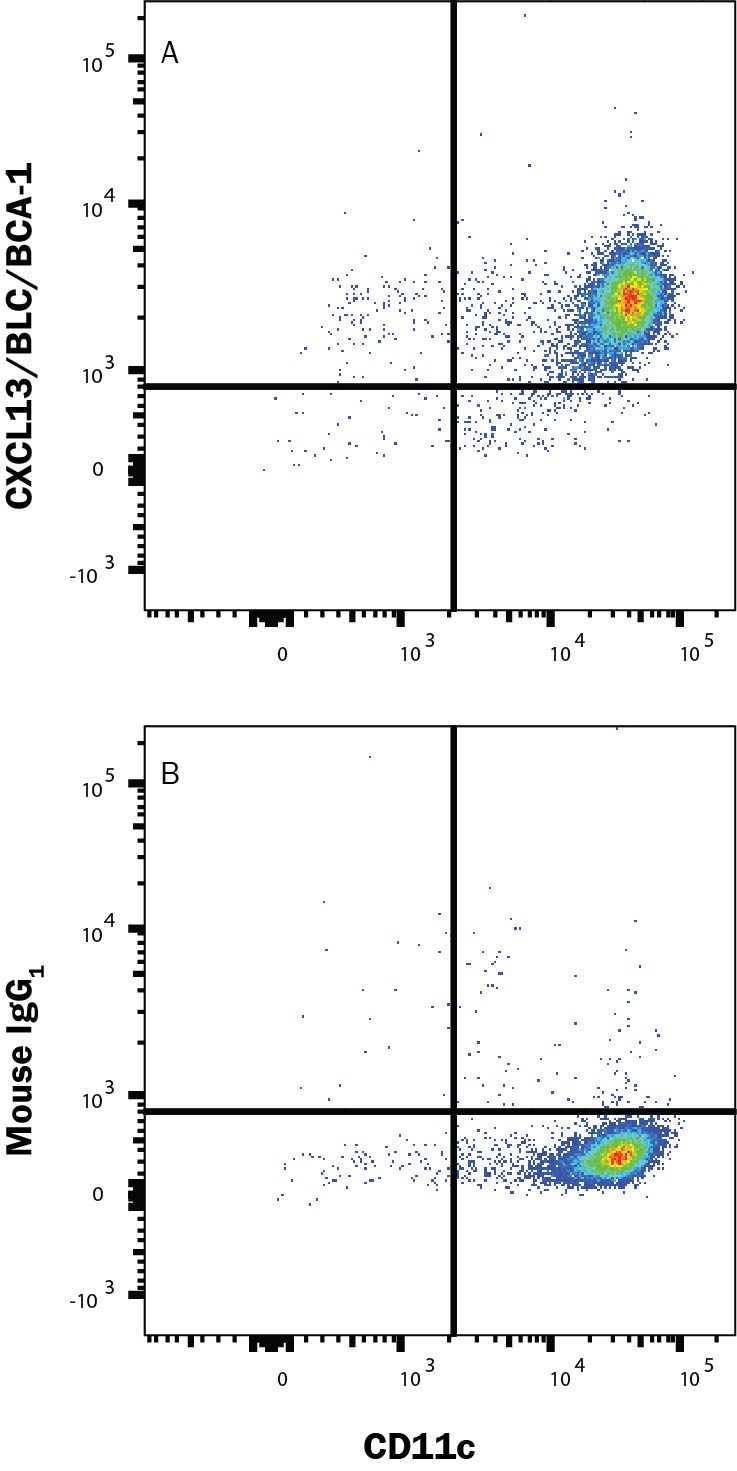Human CXCL13/BLC/BCA-1 Antibody Summary
Val23-Arg94
Accession # O43927
Applications
Please Note: Optimal dilutions should be determined by each laboratory for each application. General Protocols are available in the Technical Information section on our website.
Scientific Data
 View Larger
View Larger
CXCL13/BLC/BCA-1 in Human Tonsil. CXCL13/BLC/BCA-1 was detected in immersion fixed paraffin-embedded sections of human tonsil using Mouse Anti-Human CXCL13/BLC/BCA-1 Monoclonal Antibody (Catalog # MAB8012) at 1.7 µg/mL for 1 hour at room temperature followed by incubation with the Anti-Mouse IgG VisUCyte™ HRP Polymer Antibody VC001). Before incubation with the primary antibody, tissue was subjected to heat-induced epitope retrieval using Antigen Retrieval Reagent-Basic (CTS013). Tissue was stained using DAB (brown) and counterstained with hematoxylin (blue). Specific staining was localized to cytoplasm. View our protocol for IHC Staining with VisUCyte HRP Polymer Detection Reagents.
 View Larger
View Larger
Chemotaxis Induced by CXCL13/BLC/BCA-1 and Neutralization by Human CXCL13/BLC/BCA-1 Antibody. Recombinant Human CXCL13/BLC/BCA-1 (801-CX) chemoattracts the BaF3 mouse pro-B cell line transfected with human CXCR5 in a dose-dependent manner (orange line). The amount of cells that migrated through to the lower chemotaxis chamber was measured by Resazurin (AR002). Chemotaxis elicited by Recombinant Human CXCL13/BLC/BCA-1 (0.05 µg/mL) is neutralized (green line) by increasing concentrations of Mouse Anti-Human CXCL13/BLC/BCA-1 Monoclonal Antibody (Catalog # MAB8012). The ND50 is typically 0.5-2.5 µg/mL.
 View Larger
View Larger
Detection of CXCL13/BLC/BCA‑1 in Immature dendritic cells by Flow Cytometry. Immature dendritic cells (CD14 selected PBMCs are treated with 20 ng/mL Recombinant Human IL-4 Protein (204-IL) and 50 ng/mL Recombinant Human GM-CSF Protein (215-GM) for 6 days) were stained with Mouse Anti-Human CXCL13/BLC/BCA‑1 Monoclonal Antibody (Catalog # MAB8012, filled histogram) or isotype control antibody (Catalog # MAB002, open histogram), followed by Allophycocyanin-conjugated Anti-Mouse IgG Secondary Antibody (Catalog # F0101B). To facilitate intracellular staining, cells were fixed and permeabilized with FlowX FoxP3 Fixation & Permeabilization Buffer Kit (FC012). View our protocol for Staining Intracellular Molecules.
 View Larger
View Larger
Detection of CXCL13/BLC/BCA‑1 in Immature Dendritic cells by Flow Cytometry. Immature dendritic cells (CD14+ selected PBMCs are treated with 20 ng/mL Recombinant Human IL-4 Protein (204-IL) and 50 ng/mL Recombinant Human GM-CSF Protein (215-GM) for 6 days) were stained with Mouse Anti-Human CD11c PE‑conjugated Monoclonal Antibody (Catalog # FAB1777P) and either (A) Mouse Anti-Human CXCL13/BLC/BCA‑1 Monoclonal Antibody (Catalog # MAB8012) or (B) Mouse IgG1 Isotype Control (Catalog # MAB002) followed by Allophycocyanin-conjugated Anti-Mouse IgG Secondary Antibody (Catalog # F0101B). To facilitate intracellular staining, cells were fixed and permeabilized with FlowX FoxP3 Fixation & Permeabilization Buffer Kit (Catalog # FC012). View our protocol for Staining Intracellular Molecules.
Reconstitution Calculator
Preparation and Storage
- 12 months from date of receipt, -20 to -70 °C as supplied.
- 1 month, 2 to 8 °C under sterile conditions after reconstitution.
- 6 months, -20 to -70 °C under sterile conditions after reconstitution.
Background: CXCL13/BLC/BCA-1
CXCL13, also known as B-lymphocyte chemoattractant (BLC), is a CXC chemokine that is constitutively expressed in secondary lymphoid organs. BCA-1 cDNA encodes a protein of 109 amino acid residues with a leader sequence of 22 residues. Mature human BCA-1 shares 64% amino acid sequence similarity with the mouse protein and 23-34% amino acid sequence identity with other known CXC chemokines. Recombinant or chemically synthesized BCA-1 is a potent chemoattractant for B lymphocytes but not T lymphocytes, monocytes or neutrophils. BLR1, a G protein-coupled receptor originally isolated from Burkitt’s lymphoma cells, has now been shown to be the specific receptor for BCA-1. Among cells of the hematopoietic lineages, the expression of BLR1, now designated CXCR5, is restricted to B lymphocytes and a subpopulation of T helper memory cells. Mice lacking BLR1 have been shown to lack inguinal lymph nodes. These mice were also found to have impaired development of Peyer’s patches and defective formation of primary follicles and germinal centers in the spleen as a result of the inability of B lymphocytes to migrate into B cell areas.
- Gunn, M.D. et al. (1998) Nature, 391:799.
- Legler, D.F. et al. (1998) J. Exp. Med. 187:655.
- Forster, R. et al. (1996) Cell 87:1037.
Product Datasheets
FAQs
No product specific FAQs exist for this product, however you may
View all Antibody FAQsReviews for Human CXCL13/BLC/BCA-1 Antibody
There are currently no reviews for this product. Be the first to review Human CXCL13/BLC/BCA-1 Antibody and earn rewards!
Have you used Human CXCL13/BLC/BCA-1 Antibody?
Submit a review and receive an Amazon gift card.
$25/€18/£15/$25CAN/¥75 Yuan/¥2500 Yen for a review with an image
$10/€7/£6/$10 CAD/¥70 Yuan/¥1110 Yen for a review without an image


